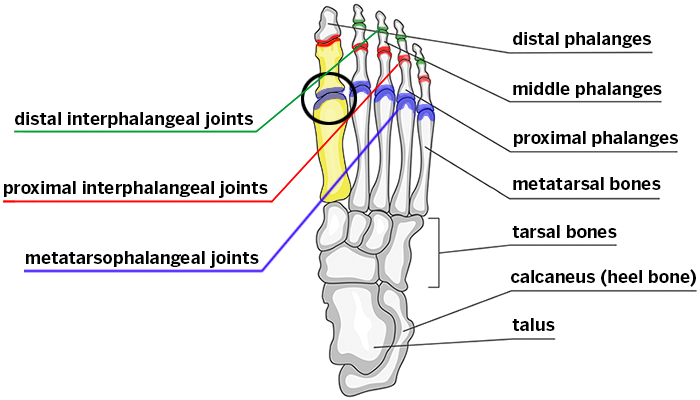Hallux Rigidus (Stiff Big Toe)
Hallux rigidus is stiffness and pain in the big toe caused by arthritis of the metatarsophalangeal (MTP) joint. (The MTP joint of each toe is composed of two bones: the proximal phalanx and the metatarsal bone.) This condition is the most common degenerative joint disorder of the foot, and it is distinct from the big toe pain caused by bunions (hallux valgus) and gout. In hallux rigidus, pain is usually most intense on the top of the toe, where a bone spur forms.

Foot anatomy showing the joint and bones affected by hallux rigidus: The
proximal phalanx and metatarsal bone of the big toe are highlighted in yellow.
Stiff big toe is common in dancers and athletes whose repetitive, high-impact movements can lead to toe injuries that later develop into arthritis. Sprains in the big toe, especially, often lead to hallux rigidus later in a person's life. (This sprain is sometimes called “turf toe,” since it often occurs during a trauma on a hard, artificial turf surface.)
Treatment
Conservative, nonsurgical treatments are usually tried first. These may include changes in lifestyle or footwear, or the use of shoe padding to limit further damage. For pain management, anti-inflammatory medications, corticosteroid injections, placing ice packs or heat on the joint, or some combination of the above may be used.
Surgical treatments vary, depending on how far the arthritis has progressed. For a patient whose toe arthritis is not in an advanced stage, a cheilectomy (bone spur removal) or an osteotomy in the proximal phalanx and/or metatarsal bone may be performed. Advanced cases usually require an arthrodesis (joint fusion) or joint resection arthroplasty. In an MTP arthrodesis, the orthopedic surgeon fuses the proximal phalanx to the metatarsal bone. This alleviates pain, which gives the patient increased mobility, but it limits the upward and downward movement of the big toe. In an MTP joint resection arthroplasty, sections of bone are removed to create more space in the MTP joint, which provides increased mobiity and reduced pain for the patient.
Articles on related conditions
In the news
